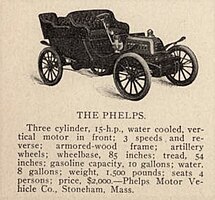
The Brass Era is an American term for the early period of automotive manufacturing, named for the prominent brass fittings used during this time for such features as lights and radiators. It is generally considered to encompass 1896 through 1915, a time when cars were often referred to as horseless carriages.
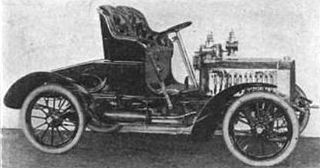
Eisenhuth Horseless Vehicle Company was a manufacturer of Brass Age automobiles who were originally based in New York City. In 1902 the company purchased the Keating Wheel and Automobile Company and established manufacturing operations in Middletown, Connecticut. During 1903, the company merged with the Graham Fox Motor Car Company, absorbing that firm and expanding operations in Middletown.

The Knox Automobile Company was a manufacturer of automobiles in Springfield, Massachusetts, United States, between 1900 and 1914. Knox also built trucks and farm tractors until 1924. They are notable for building the very first modern fire engine in 1905, and the first American vehicle with hydraulic brakes, in 1915.
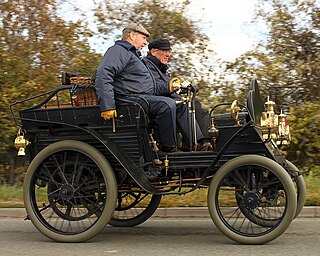
The Mors automobile factory was an early French car manufacturer. It was one of the first to take part in automobile racing, beginning in 1897, due to the belief of the company founder, Émile Mors, in racing's technical and promotional benefits. By the turn of the century, automobile racing had become largely a contest between Mors and Panhard et Levassor.
Smith & Mabley was an American veteran era importer of European automobiles and produced the American C. G. V. automobile in 1902, and the S & M Simplex automobile from 1904 to 1907, in New York City.

Stevens-Duryea was an American manufacturer of Veteran and Brass Era automobiles in Chicopee Falls, Massachusetts, between 1901 and 1915 and Vintage Cars from 1919 to 1927.

The first Cadillac automobiles were the 1903 Model built in the last quarter of 1902. These were 2-seater "horseless carriages" powered by a reliable and sturdy 10 hp (7 kW) single-cylinder engine developed by Alanson Partridge Brush and built by Leland and Faulconer Manufacturing Company of Detroit, of which Henry Leland was founder, vice-president and general manager.

Columbia was an American brand of automobiles produced by a group of companies in the United States. They included the Pope Manufacturing Company of Hartford, Connecticut, the Electric Vehicle Company, and an entity of brief existence in 1899, the Columbia Automobile Company.
The Sintz Gas Engine Company was formed in about 1885 by Clark Sintz and others in Springfield, Ohio. It was a pioneering marine engine manufacturing business that expanded into other fields. After its sale in 1902 to the Michigan Yacht and Power Company, Sintz ceased to exist in 1903 as an entity.
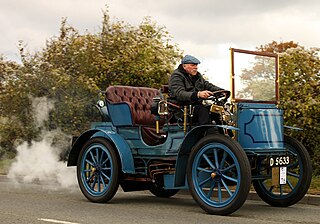
Gardner-Serpollet was a French manufacturer of steam-powered cars in the early 20th century. Léon Serpollet is credited with inventing and perfecting the flash boiler in the late 1800s.
Standard Motor Construction Company (1904-1905) was the successor to the U. S. Long Distance Automobile Company (1900-1903) of Jersey City, New Jersey. The American Veteran Era Long Distance automobile was developed into the Standard automobile in 1904.
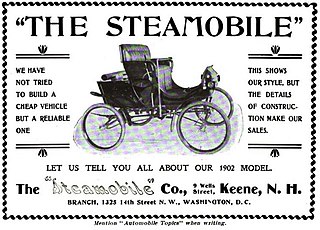
The Steamobile was an American steam car manufactured in Keene, New Hampshire, from 1900 until 1902, first by the Trinity Cycle Manufacturing Company and its successor, the Steamobile Company of America.
Spaulding was used as an automobile marque by two separate companies. The Spaulding Automobile and Motor Company of Buffalo, New York built Veteran Era automobiles in 1902 and 1903. Spaulding Manufacturing Company of Grinnell, Iowa built Brass Era automobiles from 1910 to 1916.

The Union automobile was a vehicle manufactured by the Union Automobile Company from 1902 until 1905. It was designed by John William Lambert, who had developed the three-wheel Buckeye gasoline buggy in 1891. Over the next decade, Lambert substantially refined the vehicle, with modifications including an additional wheel, a more powerful engine, and a new transmission system. The Union Automobile Company was formed as a subsidiary of Lambert's Buckeye Manufacturing Company solely to manufacture the Union, which took its name from Union City, Indiana, the city where it was built and which endorsed its production. In total, the company built over three hundred Union automobiles, before development shifted to the Lambert automobile, the Union's successor.

The Moline Automobile Company, was an American brass era automobile manufacturer in East Moline, Illinois known for the Moline, Dreadnought Moline,Moline-Knight and R & V Knight marques.

Léon Serpollet was a French engineer and developer of flash steam boilers and steam automobiles.
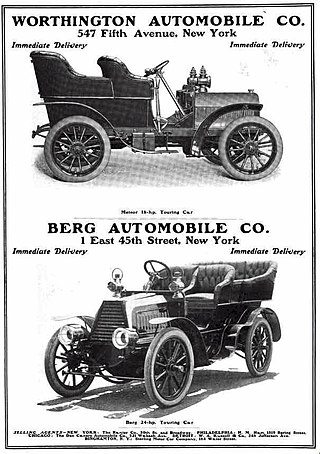
The Worthington Automobile Company was a short-lived automobile manufacturer in the United States that made automobiles between 1904 and 1905.
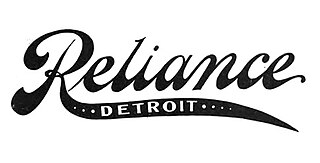
The Brass era Reliance automobile was manufactured by the Reliance Automobile Manufacturing Company in Detroit, Michigan from 1904 to 1907.

The Shawmut Motor Company was organized in Stoneham, Massachusetts in 1905 to succeed the Phelps automobile. The Shawmut was manufactured from 1906 to 1908, when the factory was destroyed by fire. The company was headquartered in Boston. A 1908 Shawmut Roundabout was the winner of the 1909 Ocean to Ocean Automobile Endurance Contest.
The Welch Motor Company was an American automobile company headquartered in Chelsea, Michigan. It began in 1901 and continued production of luxury vehicles until 1911 when it merged with General Motors.




